After centuries of human abandonment, the island of Ustica, north of Palermo, Sicily, was repopulated in 1763 in an effort to diminish the hold of the Barbary pirates in the Thyrennean Sea. But after 1840, as a consequence of the rapid growth in population, families started to immigrate to the neighboring islands. Many of them, however, chose Lousiana, via the established maritime line from Palermo to New Orleans. From 3,563 inhabitants in 1850 the population of Ustica fell to 1,200 in 1890. In 1860, there were 896 persons of Italian origin living in New Orleans, of whom 10% were from Ustica. By 1890, more than 90% of the Italian-American population in New Orleans had come from Sicily and the Aeolian islands, A few families had come over from Corsica and Sardinia.
In Louisiana, the Usticans became a leading force in commerce however their influence in the musical world was of great importance. The Tranchina family became famous for its various restaurants established between 1890 and WWII in New Orleans, especially at Spanish Fort, where Armand Piron’s orchestra played between 1918 and 1928. Trumpeters Sharkey Bonano, whose parents were from Ustica, and Leon and Louis Prima, whose mother Angelina was from Ustica, became internationally known musicians. The Bertucci family became equally famous for its restaurants. They also opened groceries and dairys. One cannot, however, overlook the importance of John J. Bertucci, a violinist, lost to history, as were many other musicians who eventually turned to jazz music.
A very large family, many of the Bertuccis immigrated to Louisiana. The Usticians had a habit of giving the same Christian names to children of different branches of the family, with slight variations. The result was that at the end of the 19th century there were at least three Bertuccis with the name John J. in Louisiana, and they were first cousins. Their parents were all born in Ustica, and had immigrated to New Orleans between 1870 and 1900.
1) John Joseph Bertucci (1), born Giovanni Bertucci on 15 December 1876 in New Orleans, the bandleader, was the son of Antonino Bertucci (b. 16 March 1848 Ustica) who was married in 1876 in New Orleans to Caterina Battifora LaRosa (b. 7 June 1837, Ustica; d. 9 June 1910, Biloxi, La). Giovanni John was married on August 28, 1899 in New Orleans to Grazia "Theresa" Favaloro (b. September 1873). A fruit dealer, he was enumerated in the June 1900 census, living with Grazia/ Grace in the Sixth Ward, at 111 Union Street, Morgan City, St. Mary Parish, LA. John J. did not stay married to Grazia. She remarried in 1919.

The Bertucci family in 1908.
2) John J. (2) (b. 1896 Louisiana) and Salvadore Joseph (b. 22 February 1892, Birmingham, AL; d. 5 July 1990, Gulfport, (MS) Bertucci were brothers that ran a produce company and were owners of the Splendid Cafe. They were married to the Catchot sisters, Eura and Bernice. John’s and Salvadore’s parents were Francesco Bertucci (b. 30 December 1858, Ustica; d. 27 April 1924, Gulfport, MS) who had been married on June 3, 1882 in New Orleans to Caroline Battifora (b. abt. 1867 New Orleans; d. 19 March 1918, Biloxi, MS). 3) John Joseph Bertucci (b. March 23, 1896, N.O.; d. 1924) was a farmer. He was the son of Felice Bertucci (b. 6 February 1864, Ustica; d. 17 October 1958, Gulfport, MS) who married Antonina Travia (b. 28 December 1869, Ustica; d. 1955, Gulfport, MS) on April 29, 1890 in Ustica. So, Francesco, Antonino and Felice were brothers, all living on the Gulf Coast of Mississippi and each had a child named John J. Bertucci. Their parents were Francesco Bertucci (b. bef 1826 on the island of Lipari; d. bet 1848 and 1890) who had married Bartolomea Licciardi (b. January 13, 1826; d. 2 March 1900, New Orleans) on September 9, 1845 in Ustica.
The first mention of John Bertucci I in the press appeared in the July 22, 1907 «New Orleans Item», reporting the organization of the Burtheville Pleasure Club, with John J. Bertucci and Nicholas Dausner as the two prime promoters: “The members have chosen as their headquarters for the present the rooms No. 2310 Calhoun Street. The following officers were elected: Frank Taylor, president; Frank Bertucci (probably a cousin), vice president; N. Dausner, financial secretary; Jacob J. Hess, recording secretary; Edward Villemeur, treasurer.”
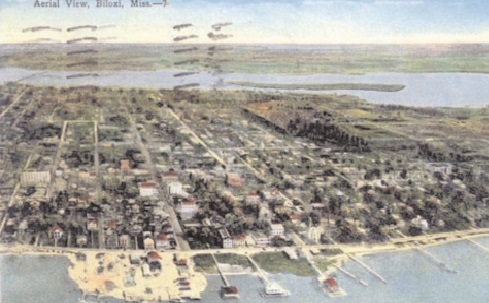
Aerial View, Biloxi, MS.
The Start of John’s Musical Activities
A violinist, “Toots” John Bertucci was associated with music from the time, when he was a youngster, that a Negro taught him the scales on a trumpet, until he died. He began playing with the Morgan City City Kids band. He organized a band while he worked at Godchaux’s in New Orleans and it played for the Godchaux’s employee outings. He organized Bertucci’s Band at the New Orleans Skating Rink in 1902. Eight years later, he headed Bertucci’s Military Band. During his years in vaudeville, his band was the Imperial Jazz Band.
The first mention of his musical activities was in «The Daily Picayune» dated April 25, 1909, where it was reported that an 8-piece orchestra, directed by Prof. John Bertucci and Prof. Russell, played for the 26th anniversary of Peter Messina, at his home on 837 Hospital Street, New Orleans. Among the guests were T. Lala and many other Sicilians.
John J. (1) was enumerated in the 1910 federal census living in New Orleans’ Third Ward, at 1710 Cleveland Avenue, with Grace and her parents John and Rosie Pavaloro. In June, John lost his 33-year-old mother, who resided in Biloxi.
About that time, John J. became the bandleader of the Knights of the Maccabees, and the «New Orleans Item» of December 18, 1910 reported that John Bertucci’s brass band furnished the music for the Maccabees the previous day. John Bertucci’s band was to furnish the music again when the Maccabees opened their first state convention at the Crescent Theatre on March 17, 1911. The New Orleans Item of April 30, 1911 reported on a banquet given by the Tulane Tent No. 19, Knights of the Maccabees, at Cieutat’s French Restaurant in St. Bernard Parish. The members assembled at 139 South Claiborne Avenue. They followed the band led by John Bertucci and the whole procession marched out to the riverfront, after which the Knights boarded trolleycar marked “Dauphine” street. Bertucci’s tent brass band furnished the music for the first open-air festival organized by the Tulane Tent No. 19, Knights of the Maccabees on May 28 at Southern Park. On this occasion, a baseball game between married and single men was organized. On December 2, 1911, the Tulane Tent No. 19, Knights of the Maccabees entertained at the Odd Fellows’ Hall with their annual reception. The Maccabee band, under the leadership of John Bertucci, played for the dance.
The band played at Southern Park on Sunday April 21, 1912 for another Maccabees open-air festival. The midsummer fair and festival of the Crescent City Carnival and Athletic Club of St. Bernard, held a benefit to replenish its Mardi Gras parade fund, on August 18, 1912 at Hernandez and North Peters Streets, Stock Landing, which was a financial success. As usual, the hall was artistically decorated, illuminated with many incandescent electric lights, and dancing to the sounds of the Maccabee band, under John Bertucci was the main attraction. On Sunday night December 29, 1912 Santa Claus visited the Maccabees with toys for the children of its members: “The music was provided by the tent’s orchestra, under the direction of Professor John Bertucci.”
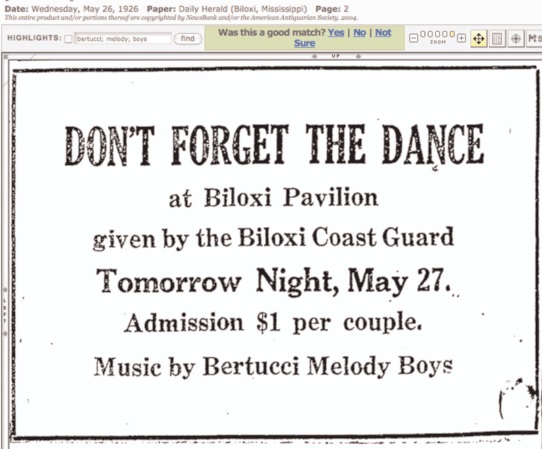
Other associations used to engage Bertucci’s band. On March 23, 1913, his Maccabee band furnished the music for the picnic given by the Merry Widows at Brunning’s new pavillion at West End.
During his 1953 interview Manuel Mello, the great cornetist, said he played with Johnny Bertucci, Johnny Sparicio, as well as with Austin and Angelo Pellegrini, the guitar player: “Bertucci had a steady line-up for a while; he had dissention in his band.” The Bertucci band, ca. 1911 featured Bertucci on the violin, Angelo Pelligrini on guitar, Babe de Rigger on bass and Manuel Mello on cornet.
The Chif’s Fair opened on October 3, 1915, and the highlight of the day was a parade of some 30 fraternal organizations, including the Woodmen of the World, the Shriners, Masons, Odd Fellows and Knights of Templar, etc. Starting at 4:30, a procession of approximately 6,000 people formed at the corner of Canal Street and Decatur, went to Baronne Street, Howard Avenue, St. Charles, Melpomene, St. Charles, Howard Avenue, Carondelet to the entrance of Washington Artillery Hall. Several drums corps and bands were in the parade, including the Elks Band, F. K. Sporer’s Band, Charles E. Boehler’s Band, Sig Christensen’s Band, Pepitoni’s Band, Johnny DeDroit’s Band, Braun’s Band, Fischer’s Band, John Bertucci’s Band, Robert Lascala’s Band and others. This was a veritable who’s who of the pre-jazz bands!
In 1918, Commissioner Stone repermitted the following saloons: S. D’Arcangelo, 2237 Josephine Street; Walter Gabriel, 1234 S. Claiborne Avenue; W.C. Springer, 2300 Calliope Street; Matt Houssa, 1701 Saratoga Street; Constant Greco, 104 St. Charles Avenue; S. Segreto, 833 Decatur Street; W. (Billy?) Struve, 622 Common Street; John Bertucci, 3341 Tulane Avenue; A. Diccio, 810 S. Rampart Street; Angelo Sciortino, 1300 St. Claude Street. This “John Bertucci” was most likely not the bandleader who, according to his draft registration card, was living with Ada at 636 Lameuse, in Biloxi, Harrison Co., MS, at that time and was employed as a painter by the Coast Ship Company, in Bayview. John J. had married Ada Barbara Ates (1895 - 1980) on December 5, 1919, and the following year their son John Edward (b. March 22, 1920; d. 1986) was born in Biloxi.
The Relocation to Biloxi
John J. (1) and his cousins John J. and Salvador/Salvatore
settled in Biloxi and Gulfport ca. 1918 following other members
of the large Bertucci family including John’s parents,
Antonio and Caterina. Salvador and John were involved in
business quite early. In 1912, Salvador Bertucci and John
Tranchina were members of the Monarch Club, and in 1915,
when John Bertucci married Miss Eura Catchot of Biloxi, he
was the manager of the Bertucci Produce Company. His brother,
Salvador, filled in for him at the company while the couple went to New Orleans for their honeymoon.
Around that same time, John J. (1) and Ada opened a confectionary shop at 423 Reynoir Street, Biloxi. John did not quit music, but changed his style: “John Bertucci has organized a new jazz band for Biloxi and other coast cities and they will play in Biloxi on Saturday night for their first time. The members of the band are Biloxi and Gulfport musicians.” John had adapted very quickly to the new musical trend with his Bertucci’s Melody Boys. His cousins John and Salvador were equally as enterprising, but in another field.
The Splendid Café
The Splendid Café at 1300, 26th Avenue, Gulfport, was
opened in 1921 by Louis Stratakos and James Karides. In
March the dining room was refurnished and decorated for a
first class dining room. In June, Louis Stratakos sold his interest
in the Splendid Café to James Karides. By the end of
the month George Pope, of Mobile, AL, one of the bosses of
the well known firm of the Three Georges’ Candy Company
of Mobile, purchased a half interest in the Splendid Café. Associated
with Mr. and Mrs. Karides, who had managed restaurants
successfully in several large cities, an up-to-date
restaurant was now to be conducted, and the building adjoining
would be occupied by an up-to-date French Market.
Finally, in December the announcement of the purchase of the iSplendid Café by the Bertucci brothers was made in the press. The restaurant closed a few days, to be redecorated, and reopened on December 20, with George Planters assisting the Bertuccis.
According to the April 21, 1929 edition of the Times-Picayune, “The Splendid Cafe is one of the largest restaurants on the Mississippi Gulf Coast and is operated by the Bertucci brothers. One of the specialties of the variety of high class food offered to patrons is the fresh sea food that is the most popular edible of the Gulf Coast. […] Managing the restaurant is Salvadore Bertucci, a veteran of the restaurant business.” In November the same newspaper confirmed that Salvadore was in charge: “The restaurant caters to many tourists, with fresh seafood, vegetables and milk and butter.” John’s wife, Eura (Catchot) Bertucci was the cashier at the Splendid Cafe. During the nineteen fifties, she was living at 628 Lameuse Street, and Salvador and Bernice were also still living in Gulfport.
The Splendid Café was still in business during the 1940s, as bluesman J. B. Lenoir (1929 - 1967)), who lived in Gulfport, worked there during this period. The Splendid Café was destroyed during hurricane Katrina in 2005.

The Bertucci Melody Boys
The Gulf Coast was and still is a place for tourists. The Bertucci
Melody Boys mainly played on the Gulf Coast, where
they had plenty occasions to work in the big hotels, for the
local organizations, or for sporting events.
The band played for the dedication of the Avalez Hotel in 1924, of the D’Iberville Bridge in 1927, and Colonel Apperson’s Buena Vista Hotel. It also played for the Tourist Club and the Avelez Hotel, in Biloxi. For 17 years, Bertucci staged the Glad You Come Dances for senior citizens of Biloxi.
The Daily Herald reported that during the Midnight Baseball Frolic Show held at the Crown Theatre on July 16, 1925, “The Bertucci Melody Boys, one of the best orchestras on the Gulf Coast, will play in the pit at all times during the pictures and for the Charleston dancers. Mr. Bertucci, manager and head of this orchestra has been playing and pleasing Coast dancers and shows for about fifteen shows, and is a finished artist in handling and directing jazz orchestras. He has some of the best musicians to be found. They play regularly for dances at Biloxi, Ocean Springs, Pascagoula and Gulfport.”
On Saturday night September 26, 1925, the Bertucci Melody Boys played for a dance given by the Biloxi Yacht Club. They repeated the experience on Saturday October 17, and these dances were continued throughout the season.

Ada and John’s business proved successful, and the couple saved enough money to be able to buy some land. On October 12, 1925, «Prof. John Bertucci, leader of the Bertucci Melody Boys, in partnership with Fitz Wentzell, one of his boys, made several purchases at the auction sale conducted by Harry W. Fitzpatrick & Co., at Pascagoula Saturday. Frank Wentzell, owner of the Biloxi Transfer Company, also bought property. He has been transporting Bertucci’s Melody Boys to the auction sales for the last several months and they have contributed a great deal toward the success of the various sales. Prof. Bertucci remarked: «I have seen so many people get bargains at these auction sales and make money on them, that I decided to have a try myself, so I am casting my lot with Pacagoula». The auction consisted of the sale of 50 lots or more on Gulf View Boulevard, formerly Market Street, totaling approximately $45,000.
On Wednesday night November 17, the Bertucci Melody Boys furnished the music for the Grand Opening Dance Ocean Springs Fire Co. No 1, in Biloxi. On February 18, 1926, the band played for a boxing match the next day at the Fair Grounds Arena.
On Friday afternoon, April 6, 1926 the Bertuccci Melody Boys were hired to play before a baseball match between the Gulport and Hattiesburg teams. During this period, a lot of boxing matches were organized in Biloxi, always preceeded by music, as was the case in New Orleans. On April 13, the Melody Boys played at Lekion Arena for the fight between Jack Doyle and Zulu Kid, and the following week for the fight between Tommy Fowlkes (of Memphis) and Henry Jungles (of New Orleans).
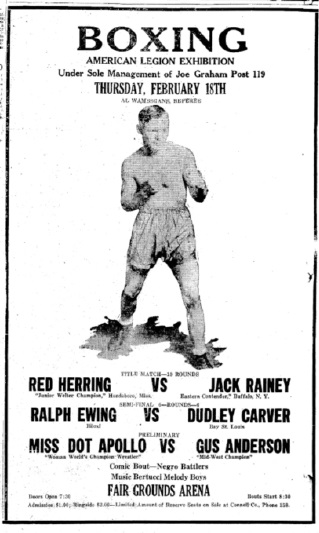
Shortly thereafter, Salvador and John J. hired John J.’s band to play at their Splendid Cafe, as illustrated by advertisements published in the April 24, 1926 Daily Herald, and other ads published throughout May and June. The band played at the Splendid Cafe for five years.
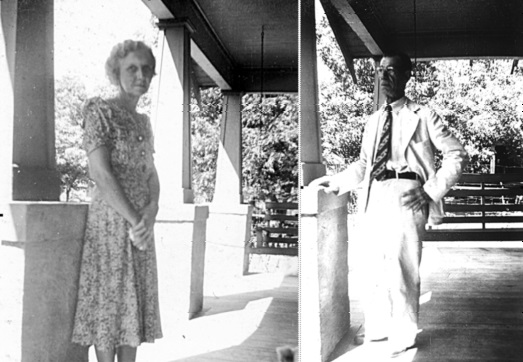
John and Ada in Biloxi.
The band was often engaged for private affairs. On May 26, 1926 they played the wedding march at the announcement for a marriage at the Elks Home. The following day the band played for a dance given by the Biloxi Coast Guard at the Biloxi Pavilion.
By 1926 the Bertucci Melody Boys were considered one of the best jazz orchestras on the Gulf Coast, playing regularly for dances at Biloxi, Ocean Springs, Pascagoula and Gulfport. On December 29, 1926 the Bertucci Melody Boys played for a Dance at St. Michael’s Hall. John now represented the Musicians’ Union on the Gulf Coast.
In 1927, John Bertucci, a musician, was living with his wife, Ada, at 622 Bohn Street; while Anthony Bertucci lived at r 636 Lameuse, the bandleader former house.
On February 21, 1927 the Bertucci Melody Boys played for the Comic Maskers masquerade ball at the Biloxi Auditorium. On March 5, 1927, the Bertucci Melody Boys opened at the Tivoli Hotel, located on East Beach, Biloxi and The Daily Herald dated March 28 had a full page advertising the charms of the Tivoli Hotel. The Melody Boys were to play the whole season at the hotel, under the name of the Tivoli Orchestra.
The Tivoli Hotel, a luxurious venue with gambling, built in 1926-1927, was a favorite of the resort clientèle as well as New Orleans patrons. It was badly damaged during Hurricane Katrina, and subsequently demolished.
On June 8, 1928, the Bertucci Melody Boys played for a dance given by Sigma Delta Phi at the Hotel Markham, another famous venue. Located on Main Street, the hotel had opened its doors at the southwest corner of 21st and 14th Streets on January 31st, 1927, and was named for Charles H. Markham, a former president of the Illinois Central Railroad. With its rooftop swimming pool, large dining room and gardens, the place was a favorite of local business men and often used for social gatherings. The Security Savings and Loan Co. acquired the hotel in the 1960s, but the place closed in 1970. Reopened in 1987 as the Markham Building, it was flooded during Hurricane Katrina, then sold again. Today the derelict building, the last of its kind on the Gulf Coast with the exception of the White House in Biloxi, is likely to be repurposed as a casino and hotel resort.
John Bertucci, a musician, was enumerated in the 1930 federal census with his wife, Ada, their sons John E., age 10, and Anthony J., age 7, and daughter Mary C., age 5, at 622 Bohm Street in Biloxi. In addition, they had four lodgers, all musicians in an orchestra, most probably the Melody Boys: Salvador Guttierez, age 23; Emile Guérin, age 21; Antony Fongert, age 28 and William Abraham, age 37. John and Ada still ran their Candy Shop at 423- 427 Reynoir Street. By 1936, Johnny’s son John was now a student. John J.’s father Antonino died on March 3, 1937 in Biloxi.
The last announcement to be found for the Bertucci Melody Boys ran in The Daily Herald dated August 24, 1934, on the occasion of a dance that was to be given the next evening at E. P. A. Hall, Biloxi with “unexcelled music.”
According to the April 1940 federal census, John J. (1) and his family were enumerated both in St. Charles, Louisiana as well as at his Bohn Street address in Biloxi. He was still listed as a musician, living with forty-four-year-old Ada, his sons, twenty-year-old Edward, nineteen-year-old Anthony, and fifteen-year-old daughter Mary. As late as 1949, John J. and Ada were still at the same address, with their daughter Mary. John J. retired from music in the late 1940s. In 1958, he and Ada were living at 127 McDonnell Street. John Joseph Bertucci died in Biloxi on December 25, 1961 and was interred at the Biloxi City Cemetery. His wife died on June 9, 1980 in Biloxi and was interred with him. She was survived by her children John (Elsie) Edward Bertucci (1920 - 1986), Anthony Jerome Bertucci, and Mary Catherine Bertucci Holliman.
DAN VERNETTES, BO LINDSTRöM, CHRIS CARAVELLA
Dan Vernetts, french, rumbeter, singer of spirituals e leader of band, published books of history of Jazz vith Bo Lindström, swedish, retired professor of theRoyal Institute of Technology in Stockholm, clarinetist and jazz history researcher. See their website at www.jazzedit.org. Chris Caravella, geologist, president of Saint Bartolomew Society in New Orleans, is onorary member of the Centro Studi.
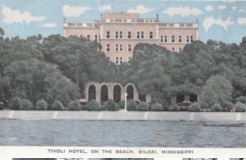 | 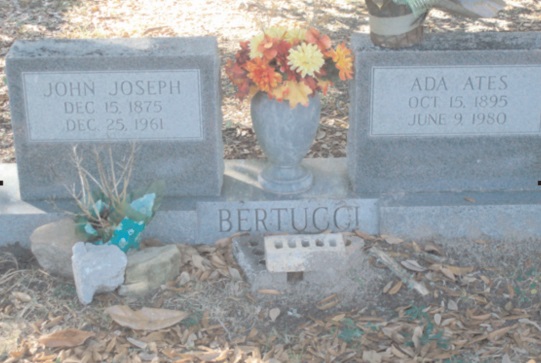 Biloxi Cemetery. |
Note
1. Grazia Favaloro was married to Pietro Bonnano on 12 September
1889 (he was 22 she was 16).
2. Their neighbors, the Francioni famil, ywere from Corsica.
3. Burtheville is a district in New Orleans.
4. Uptown Carrollton, a few blocks behind Tulane University.
5. Johnny Bertucci’s obituary in The Daily Herald.
6. At the corner of Canal Street and Claiborne.
7. The Maccabees were one of the more successful of fraternal benefit
societies which sprung up after the Civil War. Families of
deceased members received benefits in the form of legal-reserve
insurance. All white persons from birth to 70 years of age, were
eligible for membership.The order was founded in London, Ontario
in 1878 and reorganized in 1883, and was similar to other
Masonic organizations in the U.S.A.
8. The Daily Picayune, March 17, 1911. The Daily Picayune became
the Times Picayune in 1914 when it merged with the Times
Democrat.
9. New Orleans Item, May 26, 1911.
10. The Daily Picayune, December 1, 1911.
11. The Daily Picayune, April 21, 1912.
12. The Daily Picayune, August 19, 1912.
13. New Orleans Item, December 29, 1912.
14. The Daily Picayune, March 23, 1913.
15. Manuel Mello’s interview, August 3, 1959, Hogan Jazz Archive,
Tulane University, New Orleans.
16. New Orleans Item, October 3, 1915.
17. The Times-Picayune, July 24, 1918.
18. The 1922 Biloxi City Directory listed Bertucci, Antonio, shoe repair,
at 404 W. Howard Avenue.
19. The Daily Herald, November 19, 1919.
20. Gulfport Daily Herald, February 22, 1922.
21. The Daily Herald (Biloxi, MS), March 29, 1922.
22. The Daily Herald (Biloxi, MS), June 23, 1922.
23. The Daily Herald (Biloxi, MS), June 28, 1922.
24. Gulfport Daily Herald, December 18, 1922.
25. The Times-Picayune, November 3, 1929.
26. The Daily Herald (Biloxi, Ms), January 4, 1927. A causeway,
undertaken in 1926, and completed in June 1932, the bridge is
close to the spot where tradition says d’Iberville first landed in
1699. Opened to motor cars in January 1927 with a big parade,
it made Ocean Springs and Biloxi one city.
27. The Daily Herald (Biloxi, MS), October 25, 1925
28. The Daily Herald (Biloxi, MS), November 17, 1925.
29. The Daily Herald (Biloxi, MS), April 6, 1926.
30. The Daily Herald (Biloxi, MS), April 12, 1926.
31. The Daily Herald (Biloxi, MS), April 22, 1926.
32. The Daily Herald (Biloxi, MS), May 27, 1926.
33. The Daily Herald (Biloxi, MS), May 26, 1926.
34. The Daily Herald (Biloxi, MS), December 30, 1926.
35. In 1931, Antonia Bertucci was enumerated at this address.
36. The Daily Herald (Biloxi, MS), February 21, 1927.
37. The Daily Herald (Biloxi, MS), June 8, 1928.
38. Bertucci’s tomb in Biloxi Cemetery.